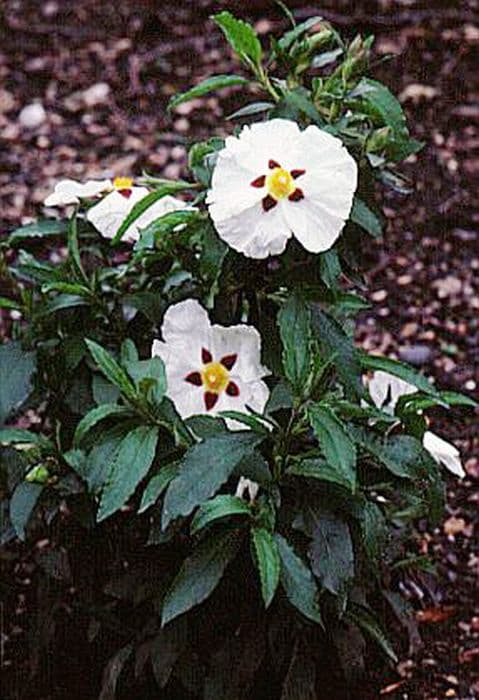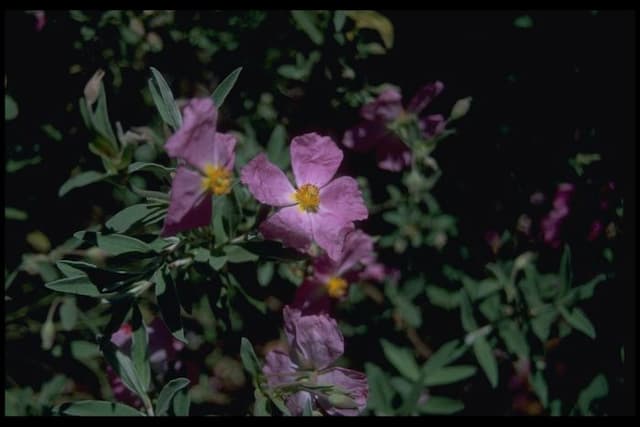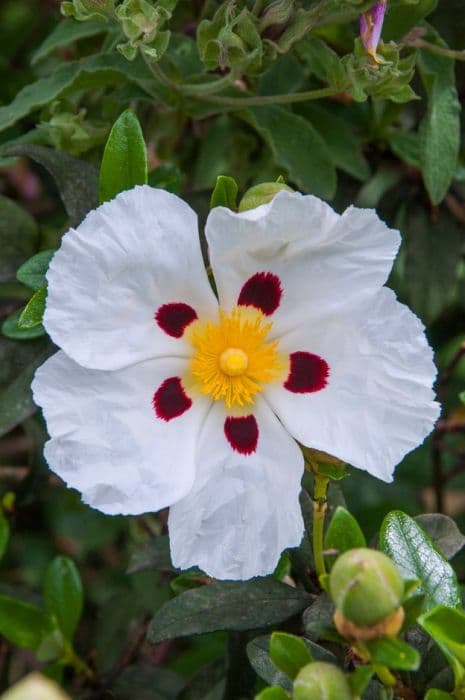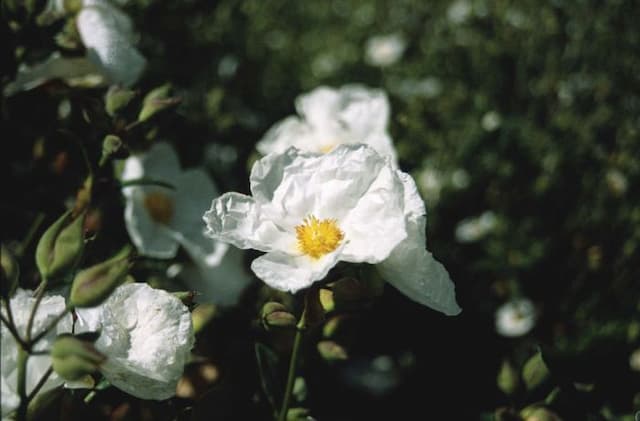Rock Rose Helianthemum 'Ben More'
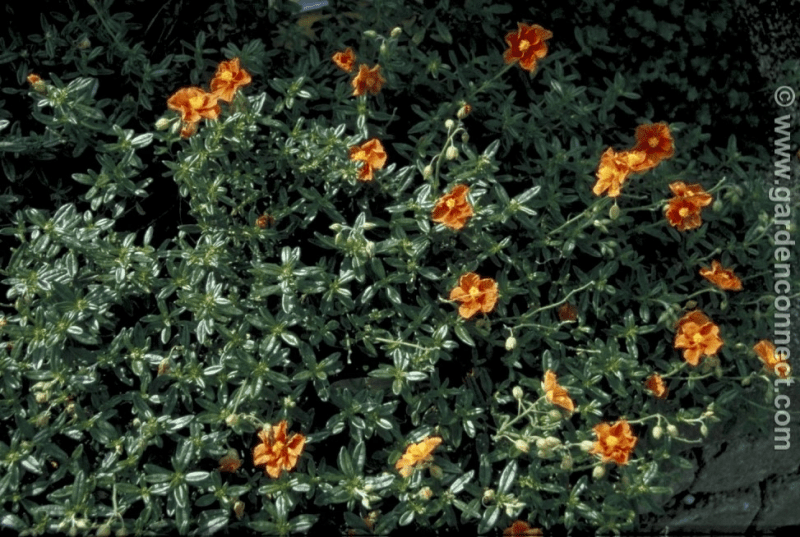
ABOUT
The Helianthemum 'Ben More', more commonly known as rock rose, is a vibrant, flowering plant known for its showy appearance. It has a bushy, mounded form that produces a dense mat of small, grey-green leaves. These leaves are lance-shaped and slightly fuzzy to touch, providing a silvery look to the foliage. During its blooming season, the rock rose is adorned with a profusion of flowers. Each blossom is crepe-paper-like in texture, with five petals that create a cup or saucer-shaped flower. The 'Ben More' variety of rock rose typically boasts flamboyant, bright yellow flowers that are particularly eye-catching. At the center of each blossom, there is often a cluster of delicate stamens, which add to the ornamental appeal of the plant. These radiant yellow flowers stand out against the silvery foliage, creating a striking contrast that can brighten up any garden space. The rock rose blooms abundantly, and while individual flowers may be short-lived, the plant produces a succession of blooms which can provide color for a good part of the season. Due to its vibrant flowers and attractive foliage, the rock rose 'Ben More' is a popular choice for gardeners looking to add a splash of brightness to rockeries, borders, or as groundcover.
About this plant
 Names
NamesFamily
Cistaceae
Synonyms
Rock Rose, Sunrose
Common names
Helianthemum 'Ben More'
 Toxicity
ToxicityTo humans
The Helianthemum 'Ben More', commonly known as Rock Rose, is generally considered non-toxic to humans. Therefore, there are no widely recognized symptoms of poisoning from ingesting parts of this plant. However, individual allergic reactions or sensitivities are always possible with any plant, so it is advisable to exercise caution if you are not familiar with how you may react to Rock Rose.
To pets
The Rock Rose plant is also generally recognized as non-toxic to pets. It is not known to cause serious illness or symptoms of poisoning in animals when ingested. As with humans, individual pets may have sensitivities, so it is wise to monitor your pet's reaction and consult a veterinarian if you observe any signs of distress or allergic reaction.
 Characteristics
CharacteristicsLife cycle
Perennials
Foliage type
Evergreen
Color of leaves
Green
Flower color
Yellow
Height
1 feet (30 cm)
Spread
1.5 feet (45 cm)
Plant type
Shrub
Hardiness zones
5
Native area
Mediterranean
Benefits
 General Benefits
General Benefits- Low maintenance: Helianthemum 'Ben More', commonly known as Rock Rose, requires minimal care once established, making it ideal for gardeners looking for easy-to-manage plants.
- Drought tolerance: Rock Rose is highly resistant to drought conditions, making it suitable for arid climates and water-saving gardens.
- Attracts pollinators: The vibrant flowers of the Rock Rose attract bees, butterflies, and other pollinating insects, promoting biodiversity in the garden.
- Ground cover: With its spreading habit, Rock Rose serves as an excellent ground cover, reducing weed growth and soil erosion.
- Long blooming season: This plant offers a long flowering period from late spring to summer, providing continuous color in the garden.
- Suitable for rock gardens: The Rock Rose is particularly well-suited for rock gardens due to its tolerance of poor soil and sunny conditions.
- Evergreen foliage: The plant has evergreen leaves, providing year-round interest in the garden, even when not in bloom.
- Winter hardy: Rock Rose is capable of withstanding colder temperatures, making it suitable for a variety of climates.
 Medical Properties
Medical PropertiesThis plant is not used for medical purposes.
 Air-purifying Qualities
Air-purifying QualitiesThis plant is not specifically known for air purifying qualities.
 Other Uses
Other Uses- Rock Garden Highlight: Helianthemum 'Ben More', commonly known as Rock Rose, adds vibrant color and ground-covering texture to rock gardens with its low-growing habit and bright flowers.
- Attracting Pollinators: Rock Rose is effective in attracting bees and butterflies, serving as a beneficial component in pollinator gardens.
- Photography Subjects: With their vivid blossoms, Rock Roses make wonderful subjects for botanical photographers and nature-inspired art.
- Erosion Control: The dense and spreading nature of Rock Rose helps stabilize soil and prevent erosion on slopes and banks.
- Edging Plants: Their compact size and ability to form mats make Rock Roses suitable for use as living edging along garden pathways or borders.
- Garden Theme Enrichment: Rock Roses' Mediterranean origin can help reinforce the theme of a Mediterranean or xeriscape garden design.
- Culinary Decoration: The flowers of the Rock Rose can be used as a decorative garnish for dishes, adding a pop of color to culinary presentations.
- Drought-Tolerant Displays: Due to its low water requirements, Rock Rose is ideal for creating appealing garden displays in drought-prone areas.
- Companion Planting: Rock Rose pairs well with other drought-tolerant species, such as Lavender and Thyme, making it a good choice for companion planting in arid gardens.
- Creative Crafts: The colorful flowers and foliage of Rock Rose can be used in various dried-flower crafts and arrangements.
Interesting Facts
 Feng Shui
Feng ShuiThe Rock Rose is not used in Feng Shui practice.
 Zodiac Sign Compitability
Zodiac Sign CompitabilityRock Rose is not used in astrology practice.
 Plant Symbolism
Plant Symbolism- Determination - As a hardy plant, Helianthemum 'Ben More,' commonly known as Rockrose, embodies a spirit of resilience and the drive to thrive in challenging environments.
- Survival - The rockrose's ability to adapt to poor soil and dry conditions symbolizes the qualities of endurance and the will to survive.
- Beauty and Simplicity - With its simple yet beautiful flowers, the rockrose represents the significance of finding beauty in the basics and appreciating the simpler things in life.
- Renewal - Rockrose plants often survive wildfires and can regenerate after being burned, which makes them a symbol of rebirth and new beginnings.
 Water
WaterRock rose should be watered sparingly; the plant is drought-tolerant and prefers dry conditions once established. Initially, water young plants regularly to ensure a strong root system, about once a week, providing approximately 1 gallon of water per plant. After establishment, reduce watering frequency, only watering when the soil is dry several inches below the surface. Overwatering can lead to root rot, so it's crucial to allow the soil to dry out between watering sessions. During particularly hot or dry spells, weekly watering may be necessary, but always check the soil moisture first.
 Light
LightRock rose thrives in full sunlight and should be placed in a location where it can receive at least 6 to 8 hours of direct sun daily. The plant is well-suited for south-facing slopes or garden spots that receive unfiltered sunshine most of the day. Avoid planting in areas with shade or partial sunlight, as this can impede bloom production and overall health of the rock rose.
 Temperature
TemperatureRock rose prefers warm climates and is hardy in a temperature range from 30 to 100 degrees Fahrenheit. However, for optimal growth, maintaining temperatures between 50 and 80 degrees Fahrenheit is ideal. While the rock rose can survive brief periods of colder temperatures, prolonged exposure to freezing conditions can damage or kill the plant.
 Pruning
PruningPrune rock rose early in the spring to maintain shape and encourage bushier growth. Cut back the previous year's growth by about one-third to promote fresh, healthy shoots and to enhance flowering. Pruning should be done annually, and the best time is when new buds begin to swell but before they open into full bloom. Pruning at this time helps ensure a profusion of flowers and a well-structured plant.
 Cleaning
CleaningAs needed
 Soil
SoilRock rose 'Ben More' thrives in well-draining, gritty soil with a pH range of 6.0 to 7.5. A mix of sand, perlite, and loam is ideal to ensure good drainage and aeration. Regular garden soil can be amended with gravel or coarse sand to improve its drainage properties, which is crucial for preventing root rot in this sun-loving plant.
 Repotting
RepottingRock rose 'Ben More' does not require frequent repotting and can be repotted every 2 to 3 years. It's important to repot only when the plant has outgrown its current container, ensuring it remains in well-draining soil to prevent root issues.
 Humidity & Misting
Humidity & MistingRock rose 'Ben More' prefers a dry to moderate humidity environment. These plants are adapted to withstand drought conditions and do not require high humidity levels, making them suitable for arid and semi-arid climates.
 Suitable locations
Suitable locationsIndoor
Ensure bright light, minimal watering, and good air circulation.
Outdoor
Place in full sun, use well-draining soil, and protect from wet.
Hardiness zone
5-9 USDA
 Life cycle
Life cycleThe common name for Helianthemum 'Ben More' is the Rock Rose. This plant's life cycle begins with seed germination that typically occurs in spring, under favorable conditions of warmth and moisture. Following germination, it enters a vegetative growth phase in which leaves, stems, and roots develop. After becoming established, Rock Rose proceeds to a flowering stage during late spring to summer, producing showy flowers that attract pollinators. After fertilization, seeds are set, and once mature, they disperse to give rise to new plants. The plant then enters a period of dormancy during the colder months, reducing activity to survive winter, and the cycle resumes with the next growing season.
 Propogation
PropogationPropogation time
Spring to Summer
The Helianthemum 'Ben More', commonly known as Rock Rose, is best propagated through semi-hardwood cuttings taken in late summer. To propagate Rock Rose using this method, select healthy, non-flowering shoots and cut segments approximately 4 to 6 inches (10 to 15 centimeters) in length. Make sure each cutting has several leaf nodes. Dip the base of the cutting in rooting hormone powder to promote root development. Then, insert the cuttings into a pot filled with a well-draining potting mix, such as a mixture of peat and perlite. Water the cuttings, and place the pot in a warm, bright location out of direct sunlight. Roots often form within a few weeks, after which the cuttings can be gently transplanted into individual pots or a suitable garden location.
